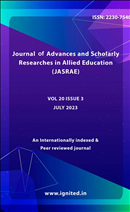Diversity and Distribution of Flora in Deoghar District Of Jharkhand, India –A Review
Keywords:
flora, diversity, distribution, Deoghar District, Jharkhand, biodiversity, spatial, temporal scales, threats of extinction, plantsAbstract
Study of floristic composition of a place, whether natural or man-made, at periodic intervalsproves essential in assessment of biodiversity in spatial and temporal scales since many of theconstituent species perceive various degrees of threats of extinction. In view of this, the present authorprioritized identification and documentation of various plants inDeoghar District of Jharkhand Statewhich is located at 24.48°N and 86.7°E with an average elevation of 254 meters (833 feet). The areaproves to be the very important resource base in terms of biodiversity and economy of the region. For itslong term sustainability and species conservation proper sustainable management practices andstrategies need to be developed.References
Arora, Sunita&SonamMeena (2016). Morphological Screening of Endangered Medicinal Plants of Milkweed family of Thardesert, Rajasthan(India).Bioscience Biotech. Res.Comm. 9(3): 406-414. Mani, M.P. (1974). The flora.In. Mani, M.S. (Editor) Ecology and Biogeography in India. Dr. W. Junk bv. Publishers, The Hague. P. 159-177.
Batanouny, K. H., &Batanouny, K. H. (2001).Climatic aridity in the deserts of the Middle East. Plants in the Deserts of the Middle East, 11-24.
Bavikatte,Kabir Sanjay(2012).Green governance foundations for agreen economy. The Hindu Survey of the environment. The Hindu publication.Pp14-26.
Bawa, K.S., A. Das, U. Karanth, J. Krishnaswamy and M. Rao (2004). Ecosystem Profile:Western Ghatsand SriLanka Hotspots, Western Ghats Region,Critical Ecosystem Partnership Fund.
Bawa,KamaljitS.(2010).Ourbiodiversity, ourlife, our future arre stingthebiodiversity decline.The Hindu survey of the Environment,pp7-17.
Bawa, Kamaljit, SandeshKadur (2013). Himalaya: Mountains of life. Ashoka Trustfor Research in Ecology and the Environment, Banglore ISBN 978-1-61584-512-2.305pp.
Benn,Joanna(2010).Whatis Biodiversity? United Nations Environment Programme, World Conservation Monitoring Centre.February2010.
Berkes Fikret& et al. (2000).“Rediscovery of Traditional Ecological Knowledge as Adaptive Management.”Ecological adaptations.10(5),2000,pp1251-1262.
Bhakat, R. K. and Pandit, P.K. (2003).Role of Sacred Groves in Conservation of Medicinal Plants.Indian Forester129(2):224-232.
Bhakat, R.K. (1990). Tribal Ethics of Forest Conservation.Yojana (March 16-31):23-27.
Bhandari, M.M. (1995). The Flora of the Indian Desert. MPS REPROSE, Jodhpur,Rajasthan.
Bhardwaj, Devendra Kumar (2018). Diversity and Status of Terrestrial Avifauna inJamwa Ramgarh Wildlife Sanctuary, Rajasthan, India. Life Sciences Leaflets:105:1-29. https://lifesciencesleaflets.petsd.org/downloadedon31December2019.
Bhattacharya, Siddartha B., Peter A. Furley, Adriyan C. Newton (2006). Impact of Community-based Conservationon Local Communitiesin Annapurna conservation Area,Nepal.Springer.425-446.
Bhattacharyya, Rajasri,Sabita Bhattacharyya & Siddhartha Chaudhary(2006).Conservation and Documentation of Medicinal Resources of India.Springer.365-377.
Brummitt,R.K.(2001).TDGW.World Geographical Scheme Recording Plant Distributions.2ndedition.
Burdak,LR(1982):Recent advanceindesertaf forestation,Dehradun,P.66
Champion,H.G.&S.K.Seth.(1968).A revised Surveyof the ForestofIndia.
Charan P.D. & Sharma, K.C. (2016).Floral Diversity of Thar Desert of Western Rajasthan, India.Journal of Phytologica lResearch29(1&2):55-71,2016.
Chhakchhuak, Linda(2007). Meghalaya, Biodiversity under threat.The Hindu survey of the environment,pp111-112.
Cox, C.B. & Moore, P.D. (1993). Biogeography: An ecological and evolutionary approach.Blackwell Publishing, Oxford.
DamNamita(1994). Floraof CherrapunjeeSub-Division East Khasi Hills, Meghalaya. Gauhati University.(PhDthesis)
Dular AK (2004). Study of Biodiversity of Sariska Tiger Reserve in Aravallis with Particular Emphasison Anthropogenic Activitiesand Conservation measures,Ph.D.Thesis.University of Rajasthan,Jaipur, India.
Dular, Anil (2015). Plant Diversity Assessment of Sariska Tiger Reserve in Aravalliwith Emphasis on Minor Forest Products. Tropical Plant Research 2(1): 30-35, 2015.GovernmentofIndiaPublication,Delhi.
IsagerL.&etal.(2002).People“s Participationin Forest Conservation:Consideration and Case Studies.FAO Corporate Document Repository.
Jain,Anita,S.S.Katewa,P.K.Galav,PallaviSharma(2005).MedicinalPlantDiversityofSitamataWildlifeSanctuary,Rajasthan,India.JournalofEthnopharmacology102(2005)143-157.
Jha, A.K. and Khanna, K.K. (2005).Plant wealth (Angiosperms) of Kanger Valley National park, Bastar (Chhattisgarh).Phytotaxonomy, Vol. 5:12-31.
Kapoor, S., and Singh, M.P. (2007). Biological spectrum and ethnomedicinal studies of plant community around the railway track embankment at Jaunpur. Adv. Pla. Sci. Vol. 20(1): 201-204.
Mani, M. S. (1974). Biogeographical evolution in India. Ecology and biogeography in India, 698-724.
Myers, N. (1990). The Biodiversity challenge: expanded ‘hotspots’ analysis. The Environmentalist 10: 243-256 pp. Myers, N., R. A. Mittermeir, C. G. Mittermeir, G. A. B. da Fonesca& J. Kent. (2000). Biodiversity hot spots for conservation priorities. Nature 403: 853- 858
Padalia, H., Chauhan, N., Porwal, M.C., and Roy, P.S., (2004).Phytosociological observations on tree species diversity of Andaman Islands, India.Cur. Sci., Vol. 87:6
Pandey, J. and Pandey, U. (2006).Floristic composition and Litter Dynamics of dry tropical woodland of Southern Rajasthan. Plant Archives, Vol. 6(2): 495- 499.
Patel, D.M., (2002). Eco-floristic and ethno medicinal studies of Taranga Forest, North Gujarat. Ph.D. Thesis, H.N.G. Uni. Patan, Gujarat.
Subrahmanya Prasad, K. and Raveendran, K. (2013).Floristic Diversity in Niliarkottam Sacred Grove in Kannur District, Kerala, India. Life Sciences Leaflets, ISSN 2277-4297, 1:64-73.
Supria Devi, L. and Yadava P.S. (2006).Floristic diversity assessment and vegetation analysis of tropical semi evergreen forest Manipur, North-East India., Tro.Eco. 47(1): 89-98.
Thomas, J., Yadav, S.S., Varghese, M. and Garud, B.D. (2004). Floristic diversity of Satpudamountains in the Western Khandesh Region of Maharashtra. Plant Archives, Vol. 4(2): 209-222.
Yoccoz, N. G., Nichols, J. D., &Boulinier, T. (2001).Monitoring of biological diversity in space and time. Trends in ecology & evolution, 16(8), 446-453.











